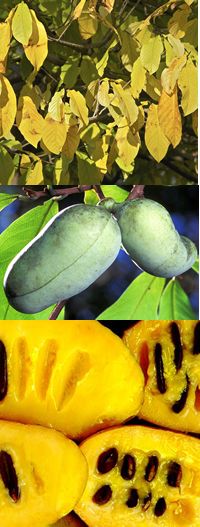This month we joined the Professional Horticulture Group South West for a visit to Charlton Orchards and the arboretum at Little Yarford Farm. In November we will again join them for their pre-Christmas lunch at Wiltshire College, Lackham, when they will invite a guest speaker, yet to be announced.
Peter Grimbly
Contents
Charlton Orchards
Plant of the Month
News from our Associates
Horticulture Industry News
Events Calendar
Horticulture Group contact details
Related Links
Charlton Orchards

They now sell to farmers' markets, plant fairs, food festivals and local shops. They currently cover six markets each week between Taunton and Dorchester and in addition produce vegetable and herb plants to sell. Other enterprises include a variety of unsweetened apple juices and bare root trees.
In addition to the six full-time staff they employ eight to ten casuals, half from the locality and half from Estonia. This Baltic link arose because one Estonian casual returned a second year with a couple of friends and the tradition has been maintained over the years.
Duncan has noticed that his customers tastes have changed over the years and they now prefer harder apples with milder flavours. The penchant for harder apples he puts down to better dental care while he thinks the move away from very strong flavours is a result of the decline in smoking.
The overall philosophy is one of low cost production but that has not meant skimping on essentials. While they use relatively few fungicidal sprays they use insecticides as and when necessary and apply foliar feeds. By looking after their hedges and field margins they are able to maintain a very good population of natural predators and their spray programmes are designed to preserve these as much as possible.
One pest they cannot avoid is deer, mainly roe deer. These live in the surrounding fields of elephant grass being grown for biofuel but will wander in to feed on young shoots. As a result all new plantings have to be surrounded by high fencing to keep them out.
The recent very wet winter has also proved a major problem and in some places they have lost 10% of their apple trees and 90% of gooseberries and raspberries no doubt due to the poor drainage of the predominantly clay subsoil.
Living trees are pruned on a 3-4 year cycle with around 2/3rds of the growth removed. The aim is to produce a low tree that can be fully harvested from a 3-step ladder.
Harvested fruit that is not immediately sold can be stored in their two cold stores, one of which can be used as a modified atmosphere store with high CO2 and reduced oxygen.
Most of the fruit had already been harvested from the trees but inevitably our tour ended in the combined packing shed and shop where we were able to see some of the excellent variety produced as well as purchase some for later consumption.
Peter Grimbly
Plant of the Month
Asimina triloba, Annonaceae, pawpaw

The name Asimina has a complex etymology, being said to be a latinised version of the French form of a North American Indian name for the plant. The specific epithet refers to the three lobed calices of the flowers. Each fruit develops from a single carpel of the flower – and up to three individual fruits (follicles) can be produced although commonly more than one aborts before maturity giving the fruit the appearance of being asymmetrically attached to the branch (middle picture by US Agricultural Research Service).
The fruit is very easily damaged and so does not travel well - meaning that it is only occasionally seen in farmers markets and rarely in areas where the tree does not grow. However, there has been a recent increase in interest in cultivating this tree in particular by organic farmers as it has very few insect pests or predators. The paw paw is the producer of a range of natural products including chemicals known as annonaceous acetogenins. These substances are toxic to most insects, except for the zebra swallowtail butterfly, which ingests these molecules and uses them to protect itself against its own predators!
Some of these molecules have been found to have anti-cancer activity and could be a promising lead for new cancer therapies.
It is also believed that this species may once have had a wider distribution, as the now extinct mega-fauna was the main distributors, having feasted on the delicious fruits. Today, the mega-fauna are the humans living in North America.
Lower picture - cut fruits and seeds by Manuel.conde.
Reference: http://www.ncbi.nlm.nih.gov/pubmed/15730242
Alison Foster
Oxford Botanic Garden
News from our Associates

CHA continues to recruit for Growtech Eurasia to be held in Antalya, Turkey between 3-6 December 2014; IPM in Essen, Germany between 27 - 30 January 2015 and Fruit Logistica held in Berlin between 4 - 6 February 2015. Working in conjuction with HDC and the Potato Council the UK presence at Fruit Logistica promises to be larger than ever. For further information on these shows and particularly the grants available to UK companies exhibiting at them, contact CHA.

The Federation will be holding its Annual General Meeting at Charles Darwin House, London on 20 November 2014.
Horticulture Industry News
For the very latest horticultural news follow us on Facebook,
Twitter, or
LinkedIn
Joining amino acids faster
Scientists have discovered a new molecule which can join together chains of amino acids. Only three other known molecules have been discovered to be able to perform this function but the new molecule is able to do the same process 10,000 times faster than the other three and 'cleanly' without leaving any residue behind. This new molecule, named Butelase-1, was derived from a common medicinal plant found in Singapore and Southeast Asia. Scientifically known as Clitoria ternatea or the Blue Butterfly Pea, this plant's blue flowers are commonly used to make food colouring. The plant is also commonly used as a traditional herb to enhance memory, as well as an anti-depressant and anti-stress agent. More
Sustainable, biological nitrogen fixation
Nitrogenase enzymes are complex structures encoded by several different genes, and the activity of these enzymes are supported by other genes scattered about the genome. It is particularly difficult to determine how many genes are required for nitrogen fixation in an organism that contains three different types of the enzyme. Scientists have instead used E. coli as a chassis to genetically engineer a functional, iron-dependent nitrogenase. They discovered that only a few genes are required to make this enzyme, which will hopefully make the system easier to engineer in other bacteria and even perhaps in crops, since plant mitochondria and chloroplasts are deficient in molybdenum. More
Certis to market Ecospray nematicide
NEMguard, a proven nematicide containing active ingredients formulated from garlic (Allium sativum) has been added to Certis’ portfolio following agreement with product manufacturer Ecospray. Garlic extract has long been regarded as a substance which protects against crop pests and diseases, but has lacked supporting trial work. NEMguard, however, is a registered product and offers a zero MRL (maximum residue limit) solution to vegetable growers. NEMguard is a granular nematicide currently registered for use on carrots and parsnips for the reduction of free living and root knot nematodes. More
Potential for new generation of fungicides
Researchers have provided novel insights into the mechanisms by which pathogenic fungi avoid the immune responses of the plants they attack. Plants that come under attack from pathogens have an automatic immune response. Fungi get around this plant immunity by injecting proteins into the host plant cells. These 'effector proteins' enable the fungi to escape the plant's immune system and allow the fungal cells to enter the plant unrecognised. Scientists have now shown that signalling organelles, known as 'early endosomes' act as long distance messengers in the fungi. They travel rapidly between the plant-invading fungal cell tip and the fungal cell nucleus. This rapid communication between the point of invasion and the fungal cell nucleus enables the fungus to produce the effector proteins that help evade the plant's immune response from the moment the fungus enters the host tissue. This signalling mechanism occurs very early in the fungal infection process, at a time when the fungi are most accessible to fungicide treatment. Disabling the process could result in a new generation of fungicides that are able to act before the fungus has damaged the plant.
New Head of School of Horticulture at Kew
Tim Hughes has been appointed as Head of Kew’s School of Horticulture. Tim will be moving from his role at the helm of the Royal Horticultural Society’s education programmes, and will bring his significant experience and understanding of the horticultural education and training sector to the role at Kew. Kew has been training young horticulturists for over 150 years and its School of Horticulture has been delivering the highly-regarded three-year Kew Diploma in Horticulture since 1963, together with apprenticeships, internships and other training courses. More
EU taxes on Kenyan imports continue for now
The East African Community (EAC) has finally reached a trade agreement with the European Union. After two days of talks in Brussels they signed an Economic Partnership Agreement (EPA). This means that the import duty Kenyan horticultural exporters to the EU were paying from 1st October will be scrapped in the coming months. Scrapping of the tax, varying from 5 to 8.5 percent, also means that Kenya’s horticultural products can compete favourably in the European market with non taxed goods from neighbouring countries like Tanzania, Uganda and Ethiopia. However, Since the trade agreement was signed after the EU deadline of 1 October had passed, Kenyan exporters of flowers and vegetables will still have to pay the import tax until the deal is ratified by the parties involved.
Garlic injection could tackle tree diseases
Injecting trees with a concentrated form of garlic might help save trees in the UK from deadly diseases. Operating under an experimental government licence, a prototype piece of technology to administer the solution is being trialled on a woodland estate in Northamptonshire. Widespread use of the injection process is impractical and expensive but it could potentially help save trees of historic or sentimental value. Garlic is one of nature's most powerful antibacterial and antifungal agents.
It contains a compound called allicin, which scientists are interested in harnessing. The experimental injection device is made up of a pressurised chamber and eight 'octopus' tubes. More
Search for a dead-end trap crop
In sustainable pest management, insect pests can be manipulated by utilizing the relative attractiveness of different host plants. Plants attractive for oviposition but not offering a suitable resource for the development of larvae are called dead-end trap crops. In a study, the number of eggs and larvae and larval survival of the pollen beetle, Meligethes aeneus, in the buds of Brassica napus L., B. rapa L., B. nigra L., B. juncea L., Eruca sativa Mill., Raphanus sativus Pers. and Sinapis alba L. were compared in 2011 and 2012. Overall infestation rate of buds varied from 0 to 71 %. Dead larvae were found only in E. sativa and R. sativus buds. Over the two study years, 19 % of larvae on E. sativa and 35 % on R. sativus were dead. In conclusion, M. aeneus preferred to oviposit on Brassica species rather than on cruciferous plants from the other genera. In addition, R. sativus (raddish) has the features of dead-end trap crop because 35 % of the larvae failed to survive. More
Super-effective cancer-fighting berry
A team of researchers has found a compound in the berries of the blushwood tree (Hylandia dockrillii, Euphorbiacea), that can kill face and neck tumours, plus melanomas on the skin. The tree is a rainforest-dwelling variety known for centuries by local indigenous communities as having fast-acting medicinal properties. Now a drug has been manufactured using a compound found in the berry, and it’s so far been used on 300 animals. In 75 percent of cases, the tumour disappeared and has so far not come back. There's a compound in the seed which works in three ways essentially: it kills the tumour cells directly, it cuts off the blood supply and it also activates the body's own immune system to clean up the mess that's left behind. One big plus with this new drug, called EBC-46, is that there appears to be no side effects when it’s used to treat cancers, and even better, it’s super-fast at getting results, taking effect within five minutes. Whole tumours disappear in as little as 15 days. They simply fall off the skin. More
Manure fertilizer increases antibiotic resistance
Treating dairy cows and other farm animals with antibiotics and then laying their manure in soil can cause the bacteria in the soil to grow resistant to the drugs. A study now suggests that the manure itself could be contributing to resistance, even when it comes from cows that are free of antibiotics. The mechanism at work is not yet clear, but the finding suggests a complex link between antibiotic use in agriculture and resistance in human pathogens. Many bacteria in the environment naturally carry antibiotic-resistance genes, probably as defence against the antibiotics produced by some soil fungi and bacteria. A team treated soil samples with either a nitrogen-based fertilizer or with manure from cows that had never been fed antibiotics. They examined soil bacteria sampled before and after the treatment, searching for genes that encode enzymes called ß-lactamases, which break down a class of antibiotic that includes penicillin. Two weeks after treatment, the soil spread with manure contained significantly higher numbers of bacteria producing ß-lactamases than did soil treated with only the nitrogen-based fertilizer. By tracing genetic markers in the resistant bacteria, the researchers found that these bacteria came from the soil rather than from the manure, suggesting that the manure treatment had helped these natural bacteria to grow by feeding them or eliminating their competitors. The manure was particularly beneficial for Pseudomonas species, which are common in human infections. More
Events Calendar
Grow Save
6 Nov 2014, Horticultural Development Council
Cawood, UK
Citrus Biotechnology
11 - 14 Nov 2014, International Society for Horticultural Science
Shizuoka, Japan
Grow South
12 Nov 2014, Roundstone Nurseries
Chichester, UK
BCPC Weeds Review 2014
13 Nov 2014, BCPC
Harpenden, UK
Advances in IPM
19 - 20 Nov 2014, Association of Applied Biologists
Marston, UK
Croptec
19 - 20 Nov 2014
Peterborough, UK
Interpoma
20 - 22 Nov 2014, Fierabolzano
Bolzano, Italy
Crop Production in Southern Britain: Precision Decisions for Profitable Cropping
25 - 26 Nov 2014, Association of Applied Biologists
Peterborough, UK
Postharvest Research, Education and Extension
8 - 11 Dec 2014, International Society for Horticultural Science
Hochiminh City, Vietnam
Challenges for Crop Production and Quality
9 - 10 Dec 2014, Association of Applied Biologists
Harpenden, UK
Teaching and Communicating Science in the Digital Age
15 - 17 Dec 2014, Society of Experimental Biology
London, Uk
Advances in Nematology
16 Dec 2014, Association of Applied Biologists
London, UK
IPM Innovation in Europe
14 - 16 Jan 2015, PURE
Poznan, Poland
Crop Protection and the Food Chain: The Future
21 Jan 2015, Crop Protection Association
Peterborough, UK
UK Brassica and Leafy Salad Conference
28 Jan 2015, Brassica Growers Association & British Leafy Salads Association
Peterborough, UK
If you would like to advertise a forthcoming event please contact. ester.monfort@soci.org
Horticulture Group Contact Details
For submitting ideas or to volunteer to be part of a committee or a group, please contact:
Chairman - Peter Grimbly
Meetings Secretary - Alison Foster
Minutes Secretary - Margaret Waddy
Newsletter Co-ordinator - Sue Grimbly scihortigroup@btinternet.com
Group Contact - Ester Monfort Martinez, E: ester.monfort@soci.org T: +44(0)20 7598 1584
